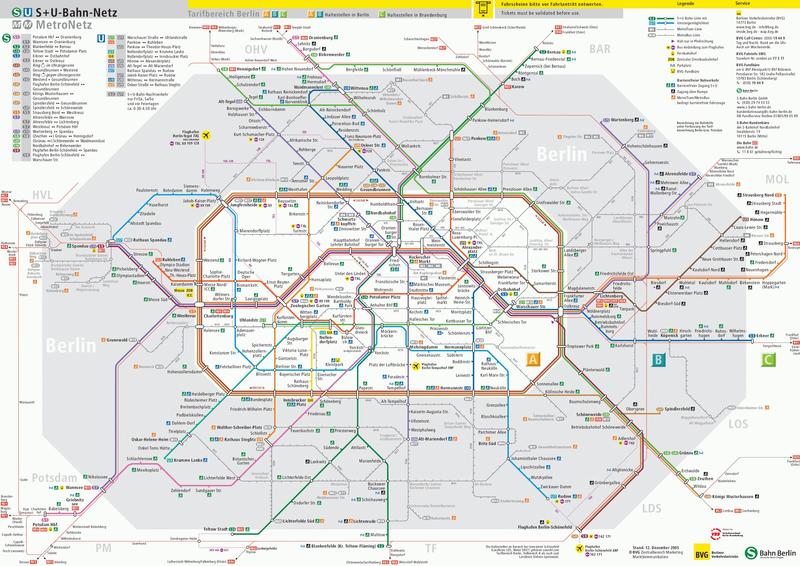The S-Bahn system of Berlin is an urban train network that connects Berlin and all its suburbs. This train system runs in parallel to and complements the U-Bahn, the light rail metro system in the city. The S-Bahn has a system length of 327.4 km and serves 166 stations. While it is operated independently from the U-Bahn, the tariffs are completely integrated, and they function as one large system.
This rail network dates to 1924, when it was inaugurated. It has, at present day, 15 operative lines that have been annexed as the city grows. Some run underground, while others are superficial, and there is even a ring line. Pricing varies according to the distance traveled, and there are three main zones. The most basic ticket costs 2.80 euro ($3.30 USD), and it allows the user to travel within the same zone. The system is open most of the day, and trains run from about 4:30 a.m. to 1 a.m. the next day.
Trains in Germany: Berlin’s S-Bahn
Berlin is the capital of the Federal Republic of Germany, one of the most powerful countries in the European continent. It is the largest and most populous city in the country, with about 3.7 million people living within the city limits. That makes it the second-largest in the entire European Union, only behind London.
Berlin is a green city, it has many parks, lakes and lots of vegetation. It has an extensive and very rich history, as it has been the capital of the German people for centuries, and was even split in two by the Cold War. The Berlin Wall was up until 1989, and it separated the Federal Republic of Germany (west) from the German Democratic Republic (east).
The city of Berlin hosts many large companies, and has become a technological powerhouse and one of Europe’s most important innovation hubs. The city is well-known for its architecture and an entire cultural industry that is present in many areas, from movies to music and all other arts.
The S-Bahn of Berlin is a public transport system that groups all suburban trains that connect the city with the suburbs that make up its metropolitan area. Some of these are: Oranienburg, Hennigsdorf, Südkreuz and Postdam.
The rolling stock that operates today dates back to the 80’s and 90’s. All the original trains (from 1930) have been retired. The BVG Class 480 trains are manufactured by AEG, Siemens and WU. The DBAG Class 481 trains are the most recent additions, being implemented in 1996. The DR Class 270 commenced their service in 1987. The S-Bahn transported about 416 million people in 2015. S-Bahn Berlin GmbH is the company that operates the system.
Brief history
Modern Berlin has always had a strong importance in the world, and its transport system reflects that. The rapid transit system was implemented quite early into the 20th century. It was the year 1930 when it became the S-Bahn. Before that, all public transports in Berlin were known as Berliner Hoch- und Untergrundbahnen (Berlin elevated and underground lines).
The operator company of the system has changed multiple times, despite always being tied to the government. At first, it was dependent on the Prussian government. It was then run by a railroad company that existed in the Weimar Republic and later in the Nazi Germany.
A few decades later, with the split of Berlin between the east and the west, the public transports met the same fate, as it was divided between the Deutsche Bundesbahn and the Deutsche Reichsbahn. Entrance from the western front was prohibited by the eastern part and the systems were cut off from each other until 1993, when the state-run company Deutsche Bahn unified the entire infrastructure and reopened the phantom stations that had been closed off.
Lines and stations
The S-Bahn of Berlin is very large, and has 15 operative lines that run in every direction, reaching many suburbs around the metropolitan area. The system is divided into three main lines: an elevated one that runs in the central part of the city from east to west; a subterranean one that runs from north to south; and an elevated circular line that circumvents the city centre. The S-Bahn lines are:
S1
This line is one of the oldest in the system, as some of it was built in 1842, 1874 and 1877 (the latter being part of the Prussian Northern Railway). The line operates in three different configurations or subgroups. The first one is known as P (or Paula), and runs the entire length of the line (51.7 km) from Oranienburg to Wannsee, and arrives at all 35 stations.
The other two serve specific areas within the line where demand is greater: P I (or Panther) runs from Frohnau to Wannsee (37.7 km) and serves 30 stations; while P II (or Pastor) runs from Postdamer Platz to Zehlendorf (12.7 km) and serves 12 stations. The S1 line is identified by its pink color.
S2
This line travels through Berlin from north to south. In its longer route, identified with the letter W (for Wulf), it runs for 46.6 km from Bernau to Blankenfelde and serves all 28 stations in the line. The second subgroup, known as W I (or Wespe) is shorter, as it runs along the 32.5 kilometers that separate Buch and Lichtenrade stations. This line is identified with a dark green color.
S25
The central part of this route is the same as S2. The distinctive color of the line is also the dark green. The first route is V (Viktor) which runs from Hennigsdorf to Teltow Stadt in 39.9 kilometers and 27 stations. The other one goes from Potsdamer Platz to Teltow Stadt and is called V I (Vampir), having a route of 21.4 kilometers.
S3
Identified by the color blue, this line is shorter than most other lines in the system, and it runs from the central part of the city to the east. The first route, known as B (which stands for Berta), runs the entire line (21.7 km), from Westkreuz to Erkner.
The second route is known as B I or Bussard, and it also runs from Westkreuz to Erkner, albeit only in certain cases. The rest of the time, it goes from Westkreuz to Friedrichshagen. The third option (B II or Benno) departs from Ostkreuz and runs for 14.6 km and serves 10 stations, it stops at Friedrichshagen.
S41
This is part of the circular line that circumvents central Berlin, known as Ringbahn. It runs clockwise and is identified with a dark brown color. It has two subgroups: A and A I (Anton and Adler, respectively). They both start and end at Gesundbrunnen station, after serving 28 stations along the 36.8 km length of the ring.
S42
This is complementary to line S41, and runs the circle in a counterclockwise manner. It also has two subgroup routes: R and R I (Richard and Reiher, respectively). It has the same length as line S41, and it also starts and ends at Gesundbrunnen station. This line is identified with the color copper.
S45
It partially shares route with the circular lines S41 and S42. It has only one group known as U I or Ulrich, that departs from Bundesplatz (Monday to Friday) or from Südkreuz station, and then follows its path for about 21.8 km, serving 12 stations until it arrives at the Berlin-Schönefeld International Airport. It is identified with a light brown color.
S46
This line shares much of its path with line S41, S42 and specially S45. This line departs from Westend and follows the ring along its southern side. The terminal station is Königs Wusterhausen, a station located at the southeastern part of the city. It serves 23 stations along a 40.6 km route, and it has only one subgroup known as D (for Dora). It shares the same color as S45.
S47
As with the previous lines, S47 shares much of its route with the ring lines, S45 and S46. It heads east after separating itself from the rest. It has a single subgroup known as K (Konrad) that runs from Hermannstraße to Spindlersfeld, serving another 5 stations along its 15.1 km of length. It has the same color as S45 and S46.
S5
This is the longest line in the system at 58.2 km. It is identified with a bright orange color. It crosses the entire city, from east to west. Its terminal stations are Spandau and Strausberg Nord. It has several subgroups. The first one, known as E (Emil) goes from terminal to terminal and servers all 36 stations on the line during daytime. At night, it runs up to Mahlsdorf.
Apart from Emil, there are another 4 subgroups: E I (Elster), E II (Eiche), E III (Erna) and S II (Sirius). Elster runs regularly from Spandau to Mahlsdorf and, on peak hours, to Hoppengarten. Eiche only runs during rush hour, from Lichtenberg to Mahlsdorf. Erna only runs in the evenings, when it replaces group Emil. It runs from Mahlsdorf to Strausberg and, every two groups, to Strausberg Nord. Sirius only runs in the high-season, but it has not been running since 2009 due to unavailability of trains.
S7
This line runs in a diagonal manner, from the southwest of the city, to its northeast. Its southern terminus is the Postdam Haupbahnhof, a central station in the nearby city of Postdam. The northern terminus is Ahrensfelde. They are separated by 47.4 km, and the two groups (Otto and Olaf) that serve this line pass through all 29 stations. Line S7 is purple.
S75
A complementary line to S7, the S75 runs from Ostbahnhof near the city centre, to Wartenberg, to the northeast. Group T (Theodor) runs the entire line, while T I (Tapir) runs from Ostbahnhof only during peak hours. The rest of the time, it runs from Lichtenberg to Wartenberg. It shares the same purple color with S7.
S8
It crosses the city from north to south, and it is identified with a light green color. It has a single subgroup called N (Nordpol) that runs for 56.4 km and serves 24 stations. The northern terminal is Birkenwerder, and the S8 runs to the southern station of Grünau. However, it also serves Zuethen station during rush hours, and the service from Birkenwerder to Blankenburg is reduced to a third during the evenings.
S85
Identified with the same color as S8, this line is complementary to it. It runs on basically the same route, except for the northern part, where it follows a different track in order to reach its terminus, Waidmannslust. From its northernmost station to its southernmost one (Schöneweide), this line known as N I (Neiße) travels for 30.3 km and serves 20 stations. It also serves Grünau station (a bit further to the south) during rush hours.
S9
Line S9 only has one subgroup: C (Cäsar). It goes from Berlin-Pankow station to its southern terminus at the Flughafen Berlin-Schönefeld (Intl. airport) along a 31.8 km route, where it serves 20 stations. It is identified with a dark red color.
Connections with other systems
German public transport is completely integrated to each other, as metro, regional and suburban trains are all connected to each other and are all complemented by urban and suburban buses. Berlin is a major example of this. It is important to note that the U-Bahn (metro) and S-Bahn (suburban trains) are auxiliary systems. While the S-Bahn reaches to the far ends of the city and connects Berlin to its metropolitan areas, the U-Bahn provides public transport within the city itself, as a metro.
All lines of the S-Bahn are connected to the U-Bahn, so they provide excellent coverage of the city. As mentioned above, buses are also an integral part of the system, as they fill all the gaps that the trains leave. The passenger may use the same ticket for the S-Bahn, the U-Bahn, urban buses, trams and ferries.
As Berlin is a very important city, not only for Germany, but for Europe itself, the German capital has many railroad stations that connect it to the rest of the continent. These stations are easily reached via the S-Bahn network, and some even share the same station.
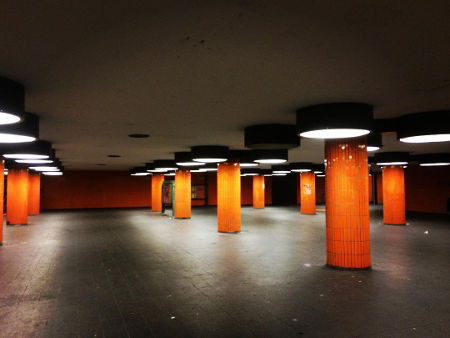
Connections to the airports
The city of Berlin has two functional airports since the closure of the Berlin-Tempelhof airport near the city centre. The Berlin-Schönefeld International Airport is outside of the city limits, to the southeast, and is connected to the city via the S-Bahn. The network reaches the airport terminal through lines S45 and S9 via the Flughafen Berlin Schönefeld station.
The other airport is the Berlin-Tegel Otto Lilienthal International Airport. It is located to the northwest, in the Reinickerdorf neighborhood, right in the city of Berlin. Despite its location, it is the busiest airport in the city and has no direct connection to either the S-Bahn or the U-Bahn. This is mainly due to the imminent closure of the Tegel as a new, larger airport being developed at the Berlin-Schönefeld nears completion. The Tegel is served by four bus lines. The Jet Express TXL connects the airport to the Beusselstraße station (served by lines S41 and S42); bus line X9 links S-Bahn S41 and S42 through the Jungferheide station; and bus line 109 complements this by connecting S5, S7 and S75 at Charlottenburg and Zoologischer Garten stations.
The Schönefeld airport is currently undergoing reconstruction and will be expanded into the new Berlin Brandenburg Airport, a very large airport that is designed to cope with future demand. The future of the Tegel Airport is uncertain. It will most likely be closed and demolished to make way for massive technological research and innovation centers, as well as other uses.
Schedule and timetables
The S-Bahn of Berlin has a complex schedule, and as with any large public transport system, each line has its own particularities. The system is open from 4 a.m. to 1 a.m. of the next day, but this can vary according to each line. Frequency of the trains also varies enormously, but near the city centre, they often run every 10 minutes during rush hour, and every 30 minutes when demand is very low.
Except for lines S8 and S85, all lines operate on weekends, and they do so with the same frequency. However, there are some lines where the frequency of the trains does increase on Saturdays and Sundays, albeit their operating hours remain the same.
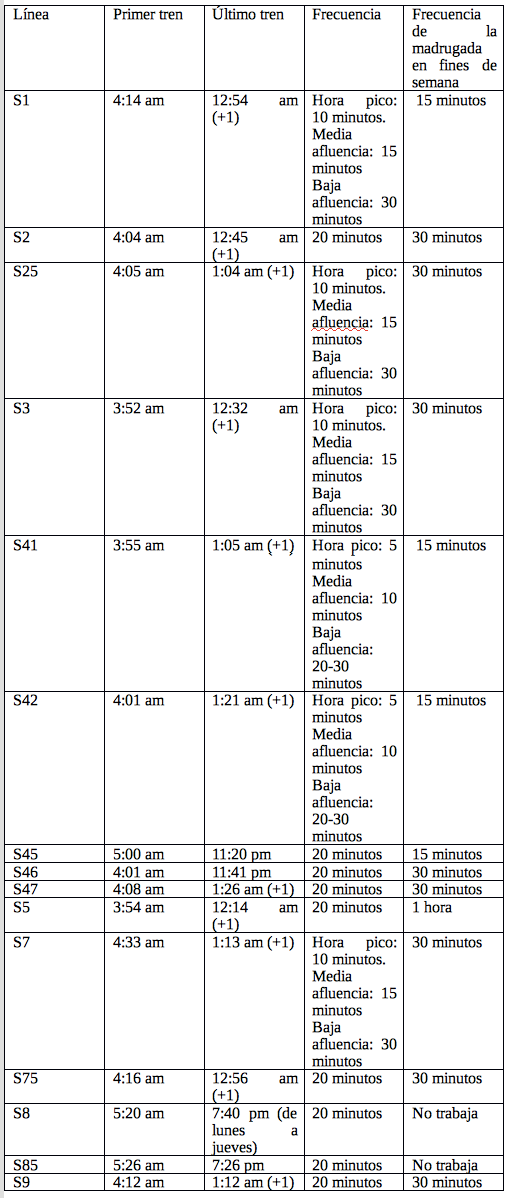
Tariffs, tickets and cards
Because the S-Bahn is such a large system, pricing is complex. The company running the network offers a variety of tickets and plans that adapt to the user’s needs. All of this is dependent on the pricing zone (A, B or C) the user needs to travel to. All tickets are compatible with any other public transport in the city, be it the S-Bahn, the U-Bahn, tramways, ferries or urban buses.
The single ticket is the best option for people who travel by public transport only occasionally. They are valid for a maximum of two hours and entitle you to unlimited travel within the system. However, this does not include return journeys (back to the starting point). Accompanying children under 6 years of age and luggage travel with the ticket holder free of charge. A reduced fare ticket is required for each pet travelling with the ticket holder. You will need a bicycle ticket to travel with a bicycle.

A day ticket enables the user to travel as much as needed within the stated day, or until 3 a.m. of the next day. This ticket is valid for an adult and up to 3 accompanying children under 6 years of age. Reduced fares are available for children from 6 to 14 years of age.
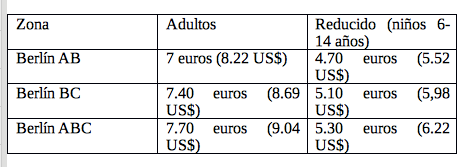
A 7-day ticket is also available, and has the same conditions as the other tickets listed above. The ticket is valid for 7 consecutive calendar days, from the time of activation until midnight of the 7th day.
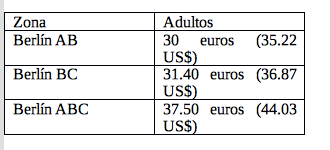
A special offer for passengers who make frequent use of Berlin's public transport services is the 4-Trip-Ticket. It consists of four individual single tickets at a better price. Each token has the same benefits and conditions of the single ticket.
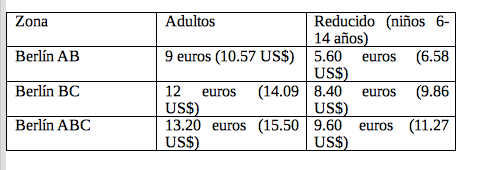
However, there are even more options. There is a special Small Group Ticket that enables up to five people to travel together as often as they want until 3 a.m. on the following day. There are also monthly and annual passes that are tailored to specific needs, and are priced accordingly. Some monthly cards are active for 30 consecutive days, while others allow the user the travel from the first to the last day of the month. Students have an important number of discounts and special or reduced fares, depending on their needs.
The public transport in Berlin also offers special deals for tourists. With them, you get a ticket for the local public transportation network as well as various discounts for Berlin’s tourist attractions and cultural highlights, no matter if you are staying 1 day or 6. They are: Berlin CityTourCard, Berlin WelcomeCard, EasyCityPass Berlin and the QueerCityPass Berlin, each with their own special deals and offers.
Future expansions
Berlin has been a difficult city for public transport design and expansion, as any plans for future growth have had their fair share of complications. World War II is a prime example of that, as many expansion plans for the existing infrastructure or for new systems were abandoned. With the construction of the Berlin Wall, the city public transport network suffered greatly.
The result of this is a complex system that cannot be easily worked on. The newer masterplan for the devolvement of the S-Bahn involves mainly maintenance and renovation of trains and stations, with some adaptations. A major renovation project is underway at the Ostkreuz station, as well as on the Görlitz railway line.
There are two main expansion projects, however. One is centered in the new Berlin Brandenburg Airport. This will add two new stations to the system, and will connect more lines to the public terminal (the current airport handles two lines).
The second expansion involves line S21, a project that has been around since the 1930’s, but is only now starting construction. It has been divided into two phases: a northern part that is already underway, and a southern part that will be completed later. They will connect through a tunnel.
S-Bahn Advices
Public transport networks in Germany operate under a system of trust, so it is important to validate the ticket after entry in order to avoid any fine that could be imposed for not having done so.
Despite being a little complicated, it is important to consider that the price changes with the distance travelled, so knowing how far your destinations are could save you some money.
It is also important to remember the conditions of the tickets, as special tariffs must be paid to carry bicycles or pets. Children under 6 years of age travel for free, and children from 6 to 14 are charged a reduced fare.
Fun facts
Despite it was inaugurated in 1924, a part of the S-Bahn of Berlin operates on railroad lines that are much older than that. After the Berlin Wall was built, the system was broken into two separate entities, one in the west, and one in the east. Several stations were closed. The only operational station where both met was at Friedrichstraße. It was heavily guarded and was more akin to a border check or customs than a station.
After that complicated time, Germany reunified and so did the S-Bahn in Berlin. The system has been in constant expansion and renovation since then, making it an efficient public transport, and an integral part of the capital.
Tourism and sightseeing
Berlin is one of the most important cities in Europe, and as such, it is also a very large tourist attraction. Although the U-Bahn is more indicated to travel within the city, the S-Bahn enables tourist to travel to the more remote areas. Some of them are:
Pfaueninsel: the ‘Peacock Island’ is a very interesting natural attraction. It is on the Havel River, to the southwest of Berlin. It is accessible through lines S1 and S7, tourists must descend at Wannsee stations and take a short ferry. It is a natural island with many animals, and it provides a chance to experience nature close to the city.
Müggelsee Lake: Berlin has an extensive fluvial network, and this lake is the biggest body of water around. Visitors may take a dip in its cold waters, or simply go enjoy the day. There are restaurants and other facilities. The closest stations are Friedrichshagen and Rahnsdorf, served by line S3.
Südgelände Natural Park: this is an 18-hectare natural park situated to the south of the city. Several historical railroad lines passed through it (like the Dresden railroad), and the ancient facilities have been conserved as a tourist attraction. There are several other attractions there, as well, such as many expositions of urban art. To reach it, tourists must head to Priesterweg station, served by lines S2 and S25.
Berlin S-Bahn Map
Map via www.bvg.deSee map full resolution. It may take a little bit to load.
Download map.
Berlin S-Bahn map
- Also Known As: S-Bahn
- Passengers/Day 1150000
- Fares: 2.8 EUR ; honour system
- 24h operation:
- Air Conditioning:
- Walk between platforms:
- Driverless trains:
- Screen Doors Platforms:
- Average Speed: 39.9 km/hkm/h
- Max. Speed: km/h
- Operator: S-Bahn Berlin GmbH
- 2.8€
- Berlin S-Bahn Metro Official Website
- Tlf: (0049) 030 297 - 43333
Help us
If you consider that the information we provide is wrong, not accurated, outdated, translation contains errors, and you would like to help us to improve the file...you can contact us here.
Feel free to contact us if you dont find the system you're looking for and we'll add it as soon as we can!
Thank you very much!





